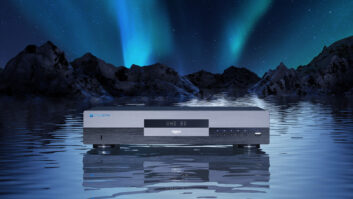It has been four months since we outfitted our showroom’s theater with a Dolby Atmos system (read about it here) and I’ve managed to get myself on Dolby’s list of Atmos Blu-ray reviewers. I have been receiving every Atmos Blu-ray disc that has been released, except for one.
For those keeping score, there are currently nine titles: Transformers: Age of Extinction, Teenage Mutant Ninja Turtles, Step Up All In, The Expendables 3, John Wick, On Any Sunday: The Next Chapter, The Hunger Games: Mockingjay – Part 1, Unbroken, and Gravity. I’ve watched nearly all of them in Atmos and the response to my last Atmos post reviewing John Wick and TMNT was so good, I thought I’d give you my reviews of the two biggest Atmos blockbusters to be released so far, Hunger Games and Gravity. (The post got to be so lengthy that I divided it into two separate reviews. Click HERE to read the Hunger Games review.)
To really experience what the overhead Atmos speakers add to a film, I watched both movies with the main 7-channel floor amplifier turned off, leaving just the four in-ceiling Atmos speakers playing. This gives a true sense of what is being mixed up to the Atmos channels.
Before I proceed, there are some serious plot spoilers ahead. Now, on to the reviews!

First, this is one of the most beautifully packaged Blu-ray movies I’ve seen. It is magnetic case that folds open to reveal a critical scene from the film, and then opens out again into four panels holding the two discs — feature film on one, special features on another — with another nice panoramic image covering all four panels inside when fully opened. The whole thing just feels like a luxury package.
Right up front I’m going to give this disc a massive compliment and a huge criticism. First the sugar: this is the best-sounding Atmos disc I’ve yet to hear. It is a textbook example of how Atmos makes home cinema sound more immersive, exciting, and engrossing. This disc is filled with aural demo scenes that totally show off the strengths of this new object-based audio technology, and it also looks absolutely stunning and is audience friendly. There are so many great demo scenes on this disc, making this is the Atmos demo disc that every store should absolutely run out and buy, and I’m predicting it will be the big demo title at this year’s CEDIA EXPO.
Now the bitter: Gravity was one of the most impressive films I’ve ever seen in 3D, right up there with Avatar for its amazing use of depth and dimension to enhance the story telling. There is already a 3D Blu-ray disc of Gravity, so why, OH WHY?!? wouldn’t they offer a 3D version WITH an Atmos soundtrack?! It just doesn’t make any sense. This should have been a three-disc release, giving us the definitive version of the film for those who want to enjoy it in 3D. I just don’t understand this marketing decision.
Even still, the 2.40:1 aspect film is absolutely reference quality in every regard, and demands to be in your library. There are also several new special features, including a “Silent Space” soundtrack where you can experience the film without music for a “surprising cinematic experiment.” Unfortunately, this version is in lossy, Dolby Digital — not TrueHD or Atmos — and I have yet to give it a listen.
When I saw this film in the theater it was not in Atmos, and I honestly don’t remember the audio much at all, short of the rapid breathing and dialog. (The closest I had got previously to seeing Gravity in Atmos was the excellent JBL Synthesis demo at this past CEDIA where they showed the trailer.) I remember being so drawn into the story and the film being incredibly tense. In fact, I found myself actually holding my breath several times as I watched Sandra Bullock having literally the most terrible, horrible, no good, very bad day. And where Mockingjay was filled with a claustrophobic sense of being trapped in a bunker underground, Gravity is filmed in the widest expanse possible — space! — yet the audio is mostly trapped inside the helmet of Bullock’s character, Dr. Ryan Stone.
The film opens with a big swell of music and what sounds like rocket engines firing before cutting to total silence as we orbit the planet earth. This silence is punctuated from bursts of stray radio transmissions and signals from NASA.
As Lt. Kowalski (George Clooney) slowly circles the shuttle in his rocket pack, Ed Harris’ voice from NASA control is mixed aggressively up to the ceiling speakers giving a real “in your helmet” sense to the audio. Throughout the repair scene in the beginning, there are scattered bits of conversations and radio chatter over the radio channels mixed quietly up into the ceiling. It’s not really meant to be understood, but gives a really nice dimension of what it would be like to work in space with stray and spurious audio being intercepted. The voices also tend to travel and bounce around the four different ceiling speakers, giving a nice sense of the movement and disorientation of floating in space.
When the order to abort the repair mission comes from Harris, it’s mixed full and loud up to the ceiling speakers, moving around through all four of the channels. This loud interruption definitely gives the urgency to the on-screen action. Moments later as the shuttle is bombarded with Russian satellite debris, there is heavy music from the overheads and Kowalski’s voice swirling around the room as he tries to locate Stone.
More than any film I’ve watched so far, Gravity does an amazing job taking advantage of the four discreet overhead speakers. Where most times these speakers almost seem to be used as one channel to create space, or ambient, or just echo the music, here they are frequently used independently to bounce, swirl and shift the audio environment around the space of ceiling. The music does a great job of matching the onscreen tension, swirling and spinning to mimic Stone’s on-screen disorientation. As Stone floats off structure and out into space, the speakers are filled with static that drifts in and out as he tries to orient herself and reach Houston.
It’s also very interesting how the dialog is used to pass through the overhead speakers as it relates to the character’s on-screen perspective, cutting from the main channels to the overhead speakers. For example, as Kowalski and Stone are floating back to the ISS, Kowalski tells Stone to “sip not gulp” her remaining oxygen and in the overhead speaker we hear Stone’s rapid breathing from the perspective of being inside her helmet.
In chapter 4, when Kowalski is about to let go of the tether to save Stone, Stone’s dialog of “I’m not letting you go!” is up in the ceiling whenever the camera cuts to Kowalski and we are hearing from his perspective. As he drifts off into space talking Stone through the boarding process of getting into the International Space Station (ISS) over the radio, his voice and static swirls around the overhead channels. His voice also drifts in and out and around as her O2 levels drop and he continues drifting further away.
This film is filled with intense scenes, but one of the most intense demos happens near the end of chapter 4 and into chapter 5 as Stone enters the ISS, all sound focuses on her lack of oxygen and her breathing sounds with the sub channel beating out a steady thump-thump heartbeat pulse. As Stone is moving around weightlessly inside the ISS there are little clanging and debris sounds inside the cluttered cabin, and when the fire breaks out, alarms blare through the overhead speakers punctuated with tense music until Stone hits her head and all audio ceases. Flames then rip and roar through the ISS until she seals the hatches, quickly followed by crumping explosions and metal clanking and groaning before Stone undocks the capsule. Not out of the woods, as Stone is trying to float free, the escape pod gets caught up in parachute straps and there is a cacophony of alarms, beeping, and straining metal.
In chapter 6, there are lots of whistling sounds punctuated by the station getting torn apart as satellite debris makes another orbit, right before Stone gets back into the aft to head to the Chinese station, Tiangong. As Stone pilots towards Tiangong, she monologues what she’s doing, her voice in the overheads along with the click and clack of buttons and switches she presses on the panel.
In chapter 7 Stone has a radio conversation with Aningaaq and during this the overheads are filled with the steady sound of venting area and a low, steady mechanical hum from the craft. When Kowalski returns and opens the hatch bringing the vacuum of space, all sounds suddenly cease, to be replaced by the hissing of air and waiting of an alarm.
As Stone enters the Tiangong in chapter 8, klaxons are blaring and emergency announcements are repeating in Chinese along with break-up sounds and metal groaning and shuddering as the ship drifts into earth’s atmosphere and starts being ripped apart. As the Chinese station re-enters the atmosphere, there is a steady swirl of things breaking up and alarms followed by the loud billow and snap of the huge landing parachute popping out.
On landing, the overheads are filled with radio static and then water as it rushes into the sinking and flooding capsule. When Stone escapes, we are surrounded by water until she breaks the surface and the overheads are filled with atmospheric sounds of wind and insects buzzing as Stone lies on the shore.
(Click HERE to read my Hunger Games review…)
John Sciacca is principal of Custom Theater and Audio in Myrtle Beach, SC.








